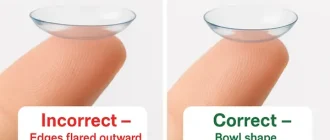What happens if contact lenses are left out of their solution? If you’ve ever found your contact lenses left outside their case, dry and seemingly ruined, you might wonder: is there any way to save them? And more importantly, how long can they survive without being submerged in solution? Today, we’re going to answer these questions by diving into the science behind contact lenses and proper care, offering the latest information you need.
Frequency of Improper Contact Lens Storage and Resulting Complications
| Storage Condition | Percentage of Complications (%) |
|---|---|
| Proper Solution Use | 20% |
| Use of Old Solution | 50% |
| No Solution (Dry Storage) | 80% |
This histogram shows the frequency of complications resulting from different contact lens storage practices. Improper storage, such as using old solution or dry storage, significantly increases the risk of infections or eye complications.
The Role of Contact Lens Solution: Why Does It Matter?
Contact lens solution plays a crucial role in maintaining your lenses. It disinfects, removes protein build-up, and keeps them moist. In short, it’s the lifeblood of your contact lenses. Without it, lenses can dry out quickly, losing their shape, becoming brittle, and turning unsafe for your eyes.
Did you know?
Contact lenses start to lose moisture after just 30 minutes out of solution, especially in dry environments. The American Optometric Association (AOA) states that even short periods out of solution can begin to compromise their integrity.
How Long Can Contacts Last Out of Solution? A Time-Sensitive Dilemma
If contact lenses are left out of their solution, the window to safely revive them is very short. Soft contact lenses can start to dry out and lose their flexibility within 15-30 minutes. After an hour, they are typically too dry to be saved safely without risking damage to the eye.
Here is a quick breakdown of what happens to contact lenses at different time intervals:
| Time Out of Solution | Impact on Contact Lenses |
|---|---|
| 15 minutes | Lenses begin losing moisture, becoming less pliable |
| 30 minutes | Lenses start to dry and lose their soft texture |
| 1 hour | Lenses are brittle, almost impossible to rehydrate |
| Over 2 hours | Risk of bacterial growth; lenses should be discarded |
Why Are Dried-Out Contact Lenses Dangerous?
When contact lenses are left out to dry, they lose their critical moisture and can become rigid and uncomfortable. This isn’t just about comfort; re-wetting dried-out lenses can introduce bacteria that multiply quickly. Even if they look okay, once lenses have been out of solution for extended periods, the risk of eye infections is very real.
According to the Centers for Disease Control and Prevention (CDC), poor contact lens hygiene, including attempting to reuse dry lenses, is a leading cause of eye infections such as keratitis. Keratitis is an inflammation of the cornea that can be both painful and potentially vision-threatening if left untreated.
Did you know?
More than 40% of contact lens wearers report having experienced at least one red or irritated eye episode due to improper contact lens care (CDC).
Is It Ever Safe to Rehydrate Dried-Out Lenses?
While you might be tempted to revive dried-out lenses by putting them back into the solution, it’s not recommended. Rehydrating lenses doesn’t guarantee that they are safe to wear. The moment a lens becomes dry, micro-cracks can form, compromising the lens structure. Even worse, bacteria can become trapped, leading to severe eye irritation or infection if reused.
The best practice is to discard lenses that have dried out and replace them with a new pair. The cost of replacement lenses is far less than the cost of treating an eye infection or dealing with impaired vision.
Table: Replacement Cost Estimates for Contact Lenses
| Lens Type | Average Cost (per box) |
|---|---|
| Daily Disposable | $30-$50 |
| Bi-Weekly Disposable | $20-$45 |
| Monthly Disposable | $25-$60 |
Replacing your lenses may feel costly, but the price of eye health is invaluable. Investing in fresh lenses will save you a lot more in terms of potential medical costs and the risk of long-term damage to your vision.
Tips for Contact Lens Safety
- Always Store in Fresh Solution: Avoid using old solution or topping off the existing solution. Always use a fresh batch to ensure proper disinfection.
- Check Expiry Dates: Both contact lenses and solutions have expiration dates. Using expired products can increase the risk of infection.
- Never Use Tap Water: Tap water may contain impurities and microorganisms that can adhere to lenses, increasing the risk of infections.
- Replace Lenses Regularly: Follow the replacement schedule given by your eye doctor—don’t extend the usage beyond the recommended timeframe.
Our Editorial Team’s Advice
The safety and health of your eyes should always come first. If you find your contacts out of their solution, it’s best to discard and replace them. The risks of eye infections, discomfort, or even more severe complications simply aren’t worth it. Always have a backup pair ready, and remember that proper care is the best way to keep your eyes healthy and your vision clear.





